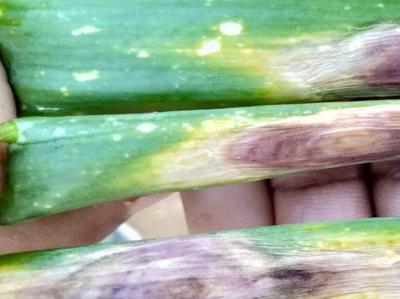Purple Blotch of Onion
Alternaria porri
Fungus
In a Nutshell
- Small, irregular, sunken and whitish specks on older leaves and flower stalks.
- At high RH these lesions develop into elliptical brown or purple blotches, with concentric light and dark zones on their center.
- Wilting of leaves or flower stalk and death.
Can also be found in
Symptoms
Symptoms depend principally on ambient relative humidity (RH). Small, irregular, sunken and whitish specks first appear on older leaves and flower stalks. If RH remains low, no further development is observed. However, at high RH these lesions develop into elliptical brown or purple blotches, with concentric light and dark zones on their central area. Over time, these lesions can spread to several centimeters long and have a yellowish border. Lesions may coalesce and girdle the leaf or flower stalk, causing wilting and death. Bulbs can also be attacked, mainly at the neck, if wounded during harvest. Storage symptoms appear as a dark yellow to reddish, spongy rot of the outer or inner scales of the bulbs. Onion, garlic and leek may be affected by this disease.
Recommendations

Organic Control
To date, no effective biological control for this disease is available. The antagonistic fungus Cladosporium herbarum has been used to inhibit the pathogen Alternaria porri on contact in vivo, reducing the infection by 66.6%. Other fungi were much less effective, for example Penicillium sp. (54%). A mixture of several antagonists can cause a reduction of up to 79.1 %. However, no commercial products have been developed on these findings so far. Aqueuos extracts of Azadirachta indica (Neem) and Datura stramonium (jimsonweed) can be used for the biocontrol of purple blotch.

Chemical Control
Always consider an integrated approach of both preventive measures and biological treatments if available. Most commercial onion crops must be protected from purple blotch by using repeated applications of protective fungicides. Solutions based on the fungicides boscalid, chlorothalonil, fenamidone and mancozeb (all @ 0.20 - 0.25%) can be sprayed preventively at fortnightly intervals starting one month after transplanting. Copper fungicides are registered for control of purple blotch, but are not highly effective. Alternate fungicides from different families to avoid the development of resistance.
What caused it?
Purple blotch is caused by the fungus Alternaria porri. It survives the winter on infected crop debris or near soil surface. It resumes its life cycle with the production of spores as warm, wet conditions occur in the spring. Wind, irrigation water or splashing rain disperse the spores to healthy plants and fields. The disease occurs under favorable conditions of temperature 21-30ºC and 80-90% relative humidity. The incidence of the disease and the intensity of the symptom also depends on the season and the conditions of the site. When it occurs together with Stemphylium blight, the damage can be serious. Resistance to purple blotch is mainly due to the thickness of the cuticle. This resistance can be reduced by wounding during field work or after sand-storm blast, for example.
Preventive Measures
- Make sure to use seeds from certified sources.
- If possible, sow and transplant early in the season.
- Choose resistant varieties if available.
- Plow field 2-3 times between seasons to expose the fungus to solar radiation.
- Increase the space between plants when transplanting.
- Fertilize generously with nitrogen and phosphorous to have strong and healthy plants.
- Control weeds in an around the fields.
- Remove debris and volunteer plants after harvest.
- Take care not to injure plants during field work.
- Crop rotations of 2-3 years prevent the pathogen populations from building up to high levels.
- Store bulbs at 1-3 °C and humidity 65-70% in a well-aerated cooler.
- Control onion thrips, as plants weakened by them are more susceptible to disease.



